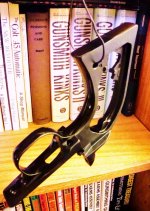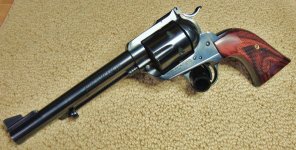2 basic types of rust bluing
--Quick Rust Blue, also called 'Express Rust Blue',, 'Hot Rust Blue'
--Slow Rust Blue, also called 'Cold Rust Blue'
Probably other names for them, but those are the common ones.
'Fume Bluing' was a kind of popular in the 1970's when a guy named Phil Pilkington, a custom gunmaker and engraver, came up with the method and published some articles about it. One was in a GunDigest.
The basic method is to place the clean polished parts in a sealed cabinet with very small amts of both Nitric and Hydrochloric acid (a few drops of each kept in separate containers,,plastic bottle caps worked well).
The idea was that the combined fumes of the 2 acids built a fine, even rust on the parts all by itself. The parts were then boiled and carded as usual for a rust blue. Then set back in the cabinet and 'fumed' again for another rusting.
I tried it several times back when and got mixed results.
Some areas rusted nicely, some not. If the acid(s) were too intense, the metal would sweat and spoil the finish. Not enough (dealing with a few drops of each), then you didn't get hardly any rusting or just some near the caps.
It did produce a very nice deep blue color when it worked.
But not a very tough finish as the other rust blue procedures do.
That along with the mixed results have kind of made the process fade from favor. Though I'm sure there is someone having found the right technique and is still using it.
Back to the traditional rust blues.
Each uses their own rusting soln's.
What works for an Express Blue, does not work for a Slow Rust Blue.
Express Blue is a start to finish project, though it may take you a couple hours to finish.
Cold Rust/Slow Rust can take several days or longer. This because you let the parts rust naturally in the air and humidity with the soln applied.
Express rust bluing the parts rust immedietly when the soln is applied to the warm parts. Then the parts are immedietely put back in the boiling water to turn the brown rust to blue/black.
Slow Rust is easier to control. It is more forgiving in that you can work over a small area that has a streak on it of blemish in the color and then go on and blend it in with the next coating.
When you are carding the parts you are do so with them at room temp because you can allow them to cool off. No need to hurry. They have to be cool anyway before you can put the next coating of rusting soln on them. Easy to handle them,,but don't touch them with bare hands!
Express Bluing,,speed is everything. The hot parts are taken from the tank and the excess water shaken off. Then immedietly they are carded while still hot.
Any water drops hiding on them and carded over will likely spoil the finish. They have to be dry.
Then you have to recoat them with the bluing soln while still hot in order for the soln to evaporate and leave a rust coating.
If the parts have cooled too much while carding and handling,,you have to reheat them before reapplication of the soln.
Oldway was to place them back in the boiling water. I generaly just heat them back up w/a propane torch.
Don't get them too hot (they only need to be 212F). Too hot and the bluing soln will sizzle and etch the surface.
Doing a set of SxS bbls , usually 2 sets, (sometimes 3 at a time) is about all you can handle and not be waiting around during an Express Blue.
If you are doing a set of bbls and an action and all the small parts, screws pins, trigger guard, plates, sights, ect, ect. Then you really have some work on your hands and it seems like forever to get back to the bbls for the next coating.
I still do Express Blue on a few projects. It just fits in better.
But I prefer Slow Rust Blue and use it much of the time.
You don't really need a special 'damp' cabinet to boost the rusting time. MOst of the soln's will rust the parts at less than 85F and 85% humidity like most advise.
Sometimes I let the parts hang for 24hrs and more to get a fine coating of rust. You don't need a coating of rust that looks like a piece of old farm equipment that's been in a field for 20yrs to get bluing.
Barely a reddish ting color will give you a coating of blue,,and very little if any matting/etching to the steel.
If you want more matting, just let it stand longer and it'll do just that.
If you want to accelerate the rusting to an hour or 2 and done,,just steam up the bathroom by running the shower Hot (plug the drain and let the water collect too.).
Then turn the water off, hang the parts on the shower rod and close the door. With the familys permission and keeping the door closed the parts will be set to go to the boiling water tank by the time the game is done.
Boil for at least 10min. before carding.
If you have a streak or bad spot in the blue finish don't be shy about taking that spot back down below the blemish even to the bare steel again. Then go right on with the process and recoat the entire part with soln. That scrubbed down area will catch right back up in color in 1 or 2 cycles.
Scotchbrite works wonders for polishing those blemishes out of the bluing during the process. Don't reuse the piece, throw it away as it may contain any contaminate that caused the problem.
I use 'Laurel Mountain Browning Soln' for Slow Rust Blue and have for the last 35+ yrs.
For Express Blue I use 'Mark Lee Express Blue Soln'.
Probably used that for the same amt of time.
Stay away from the older stuff w/Mercury compounds in it or you'll shake like me.
I just finished a Krag sporter up and slow rust blued that one.
I'll see if I can get a couple pics of it.
Haven't hot salt blued in many years. Too much stuff to deal with now with all the chemicals and EPA stuff. If you need something hot salt blued, better to take pre-polished parts to someone with the set-up and pay them to 'dunk' them these days.
Hope this helps.











